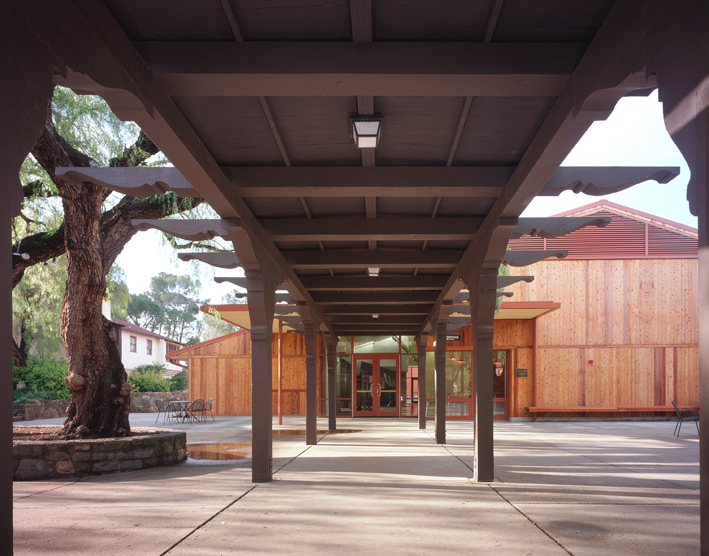Carver Commons, Thacher School

Gregory, Daniel, On Campus: A Design View, Thacher Magazine. Fall, 2009
Carver Commons, Thacher School
Ojai, California
2007
Capturing Landscape
Founded in 1889, Thacher School is set on a former cattle ranch at the base of the Topatopa Mountains overlooking a valley that runs 30 miles to the Pacific. The hillside campus is a 24 / 7 academic community of 235 students, 40 faculty, and 140 horses. Demanding studies combined with rugged outdoor life on a former cattle ranch take place on grounds expressive of school philosophy. Insertion of the Arts Building and Commons into the school's historic core prompted evaluation both of the existing campus layout and its powerful setting, the latter a quality often ignored in most of the earlier campus buildings. We saw this two-building project as a chance to explore ways to take better advantage of this remarkable landscape.
Exploiting Building / Site Relationship: One goal was to explore the advantages of constructing two different buildings side by side to maximize usefulness of adjoining outdoor spaces and enhance the overall campus experience. American campus tradition treats outdoor spaces as functional and often, symbolic components of an ideal landscape and a source of institutional identit but there are few models for how this works in mountainous terrain. At Thacher, the semi-arid ecology and beautiful views of looming peaks bring to mind the Greek landscape and with it, ancient planning strategies aimed at establishing clear relationships between sacred buildings and prominent topographic features to heighten awareness of the natural world and humanity's place in it. The setting of the school's running track looks amazingly like theancient one at Delphi.
Double-functioning Space: Two building programs were designed as one to increase efficiency and avoid redundancy. The Commons not only provides relaxed spaces for student, faculty, alumni, and conference use but also serves as lobby / reception / rest room facility for events in either building. Music practice rooms on its lower level are conveniently close to the stage door and rehearsal rooms of the Arts Building. Circulation is concentrated in a sky-lit central corridor (a "socio-petal space") interpreted like a Parisian shopping arcade with café, post office, school store. It doubles as a gallery for student work or traveling exhibitions. A tack- board kiosk, ("The Toad") provides pinup information, internet access, and soft drinks. The adjacent multi-purpose room expands the café for events.
Clarifying and Capturing: The buildings resolve a conflicted part of the campus plan and shape a space that accommodates intermission crowds, casual student use, and ceremonial functions. They also frame new view corridor to the west. The Arts Building borders a venerated triangular playing field then cranks to align with the north/south grid of the central campus and form a strong corner for the open lawn to the north. The Commons anchors the new project at the old Pergola at the center of the school. Its cantilevered deck and window wall afford a sweeping overlook of the valley. Building alignments and tall windows in the auditorium, rehearsal rooms, and café make distant mountain views the focus of major spaces.
Sustainability and Regional Vernacular: Vernacular building forms and materials enclose a technically complex program, responding to climate and natural features in a way that unifies the larger landscape. Contemporary spatial concepts, detailing, construction, and planting and lighting design are overlaid. Orientation, daylight penetration, roof overhangs and sun screens, grading and foundation design, natural ventilation / HVAC systems, and materials selections all reflect a balance between limiting construction cost and maximizing life-cycle performance. Stucco, architectural concrete, metal siding and metal roofing predominate. Client-requested wood siding is used sparingly.
Photography: Benny Chan, Fotoworks